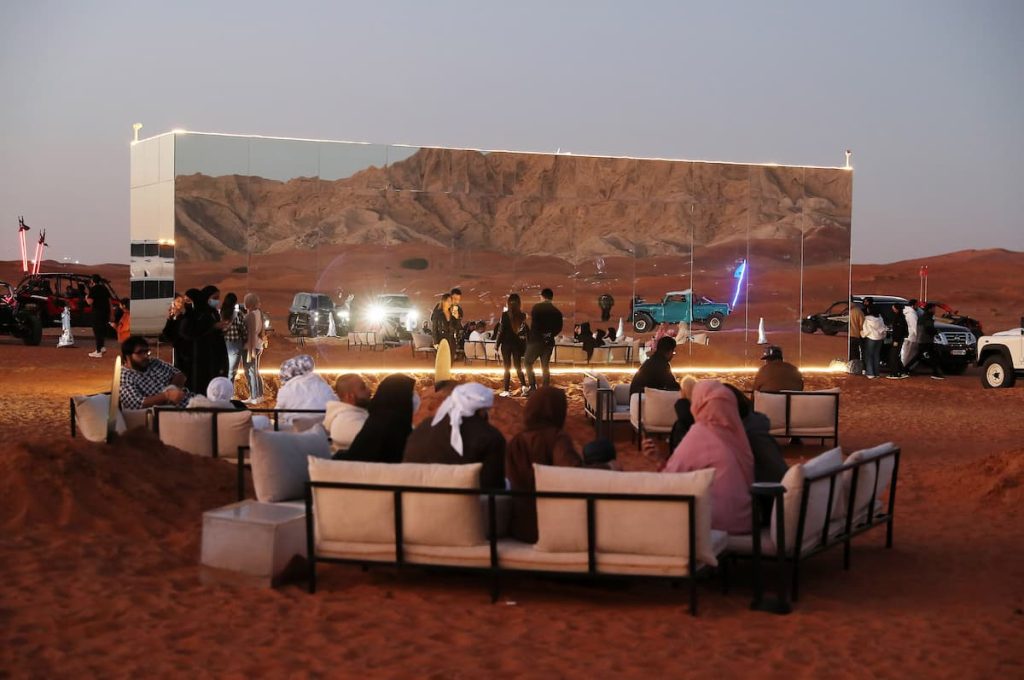Hidden Dubai, located within Al Marmoom Desert Reserve, functions as a café and cultural escape. Its setting includes reflective structures, rustic seating, fire pits, and art-friendly lighting. During winter, the space transforms into a serene venue for sculpture, performance art, or multi-sensory exhibitions. With its limited capacity, it encourages slow-viewing experiences. Reservations are essential, and most organizers collaborate directly with the on-site team for permits and logistics.
Sadeem offers a mindful setting for artistic encounters
Sadeem is another desert site in Al Marmoom known for quietude, sustainability, and minimalism. Art installations here often focus on natural materials, silence, or interaction with landscape elements. The area has hosted yoga retreats, sound-based exhibitions, and sand sculpture events. Organizing a show at Sadeem means respecting environmental boundaries and working with eco-conscious suppliers. The venue does not allow heavy machinery or permanent structures, favoring lightweight and mobile designs instead.
Mleiha combines archaeological heritage with contemporary creative expression
Mleiha Desert in Sharjah holds deep cultural significance and raw desert beauty. Artists drawn to ancient themes, time, or transformation find inspiration in its fossil beds and Bronze Age ruins. Local authorities require event organizers to coordinate with Sharjah’s heritage department to protect the landscape. Several exhibitions have paired contemporary installations with guided archaeological walks. Visitors often appreciate the context-rich experience more than traditional gallery presentations.
Kalba Ice Factory provides industrial contrast to natural surroundings
Kalba Ice Factory, on the east coast of Sharjah, is a restored industrial structure used for large-scale art exhibitions. Though not in the desert center, its backdrop features rugged mountains and dunes, offering a hybrid experience. Its wide open interior is ideal for sculptures, light shows, and projections. Artists who need wall space or controlled lighting often choose this venue. The proximity to Khor Kalba mangroves also allows eco-themed side programs.

Alserkal Avenue supports pop-up exhibitions with urban infrastructure
While located in Al Quoz, not in the desert, Alserkal Avenue frequently supports desert-inspired exhibitions. Its converted warehouses serve as prep sites or complementary spaces for artists exhibiting in the dunes. Pop-up events may launch at Alserkal, then migrate outdoors. Some exhibitions use VR or projection mapping that previews the desert experience before the actual event. The venue’s community includes curators, art handlers, and installation experts familiar with off-grid logistics.
Permits and government approvals are required for desert exhibitions
Any public event in the UAE requires municipal and police permissions. For desert exhibitions, approvals come from Dubai Municipality, Dubai Police, and sometimes the Dubai Department of Economy and Tourism. Organizers must submit site plans, crowd control details, environmental impact assessments, and security arrangements. Especially in conservation areas like Al Marmoom, additional guidelines apply. It is best to work with local fixers or production companies familiar with these steps.
Desert logistics require specific equipment and local partners
Transporting art into the desert is a logistical challenge. Off-road vehicles, mobile lighting rigs, and climate-resistant packaging are essential. Dubai-based event agencies often rent such equipment. Power generators, Wi-Fi hotspots, and portable toilets are also key for multi-hour exhibitions. Collaborating with Bedouin hospitality teams can enhance the experience. These teams provide tents, seating, refreshments, and music while honoring Emirati traditions.
Art in the desert often engages with local culture and natural symbolism
Unlike indoor galleries, desert exhibitions must respond to their surroundings. Artists often use sand, wind, or sun movement as part of the experience. Some integrate Bedouin poetry, UAE folklore, or calligraphy into their concepts. Others rely on silence, open space, and solitude to evoke emotional response. Such exhibitions create a bond between place and viewer. Respect for the land and its symbolism remains essential in curating such events.
Site selection defines the tone, scale, and message of the exhibition
Choosing the right desert site determines everything from installation size to visitor access. Venues near Dubai are more accessible but also busier. Remote dunes offer solitude but require added transport and safety arrangements. Some artists choose sunrise or sunset for timing, using the light itself as part of the medium. Every element—from wind direction to camel paths—matters in finalizing location. The best exhibitions embrace the unpredictability of the desert.
This guide was curated by the editorial team at www.few.ae.


 then "Add to Home Screen"
then "Add to Home Screen"